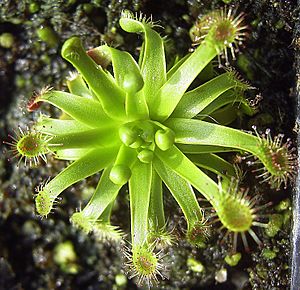Drosera stenopetala facts for kids
Quick facts for kids Drosera stenopetala |
|
|---|---|
 |
|
| Scientific classification | |
| Genus: |
Drosera
|
| Species: |
stenopetala
|
Drosera stenopetala is a special type of carnivorous plant that eats insects. It grows in a rosette shape, like a flat circle of leaves. This plant is a perennial, meaning it lives for more than two years. It's a small, herb-like plant found in high mountain areas.
The name stenopetala means "with narrow petals." But actually, its petals are quite wide! This plant is a type of sundew. It's unique because it's the only sundew found only in New Zealand. It's one of two sundew species that live in New Zealand's mountains. The other is Drosera arcturi.
Drosera stenopetala has some cool features. Its leaf stalks, called petioles, curve inwards. Its leaves also stand upright.
About Drosera Stenopetala
Drosera stenopetala is a fascinating plant. It belongs to a group of plants called sundews. These plants are famous for their sticky leaves. They use these leaves to trap and digest small insects. This helps them get nutrients that might be missing from the soil where they grow.
What it Looks Like
This sundew grows in a flat, circular shape close to the ground. This shape is called a rosette. The leaves are usually upright, which is a bit different from some other sundews. The stalks of its leaves, called petioles, have a special curve. They curve inwards, which is a key way to identify this plant.
The plant's flowers have petals that are wider than its name suggests. The name stenopetala means "narrow petals." This can be a bit confusing!
Where it Lives
Drosera stenopetala is special because it is endemic to New Zealand. This means it is found naturally nowhere else in the world. It is one of only two sundew species that live in New Zealand's high mountain areas.
You can find this plant in many places across New Zealand. Its range starts in the north, in the Ruahine and Tararua Ranges. It then stretches south along the Southern Alps. It even reaches Stewart Island. You can also find it on the Auckland Islands and Campbell Island.
See also
 In Spanish: Drosera stenopetala para niños
In Spanish: Drosera stenopetala para niños

